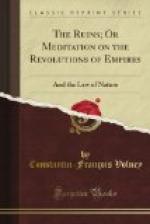Dius, which is to be understood also of the sun, must be derived from dih, a hawk. “The Egyptians,” says Porphyry (Euseb. Proecep. Evang. p. 92,) “represent the sun under the emblem of a hawk, because this bird soars to the highest regions of air where light abounds.” And in reality we continually see at Cairo large flights of these birds, hovering in the air, from whence they descend not but to stun us with their shrieks, which are like the monosyllable dih: and here, as in the preceding example, we find an analogy between the word dies, day, light, and dius, god, sun.
“Such is the chain of ideas which the human mind had already run through at an epoch previous to the records of history; and since their continuity proves that they were the produce of the same series of studies and labors, we have every reason to place their origin in Egypt, the cradle of their first elements. This progress there may have been rapid; because the physical priests had no other food, in the retirement of the temples, but the enigma of the universe, always present to their minds; and because in the political districts into which that country was for a long time divided, every state had its college of priests, who, being by turns auxiliaries or rivals, hastened by their disputes the progress of science and discovery.*
* One of the proofs that all these systems were invented in Egypt, is that this is the only country where we see a complete body of doctrine formed from the remotest antiquity.
Clemens Alexandrinus has transmitted to us (Stromat. lib. 6,) a curious detail of the forty-two volumes which were borne in the procession of Isis. “The priest,” says he, “or chanter, carries one of the symbolic instruments of music, and two of the books of Mercury; one containing hymns of the gods, the other the list of kings. Next to him the horoscope (the regulator of time,) carries a palm and a dial, symbols of astrology; he must know by heart the four books of Mercury which treat of astrology: the first on the order of the planets, the second on the risings of the sun and moon, and the two last on the rising and aspect of the stars. Then comes the sacred author, with feathers on his head (like Kneph) and a book in his hand, together with ink, and a reed to write with, (as is still the practice among the Arabs). He must be versed in hieroglyphics, must




